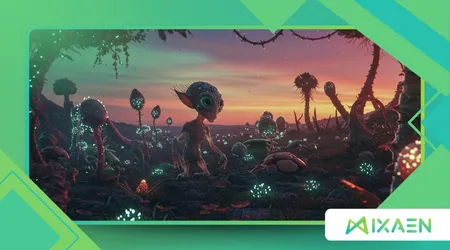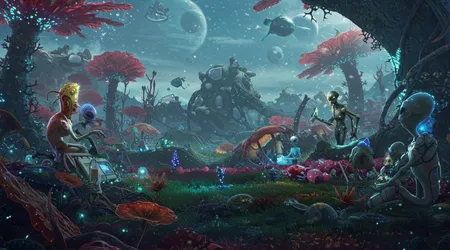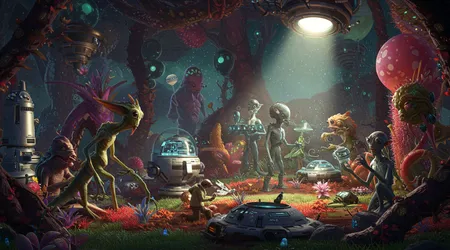Could Alien Life Be Based on Something Other Than Carbon?

Alien life has long captivated our imagination, sparking questions about its potential forms and chemistries across the cosmos.
Anúncios
From science fiction to rigorous scientific inquiry, the search for extraterrestrial organisms challenges our understanding of biology’s boundaries.
On Earth, carbon forms the backbone of all known life, its versatile bonding creating complex molecules like DNA and proteins.
But could alien life thrive on a different chemical foundation, such as silicon, nitrogen, or even exotic systems we’ve yet to imagine?
This question drives astrobiologists to explore the universe’s vast possibilities, pushing the limits of what we define as life.
Recent discoveries, like those from the James Webb Space Telescope, fuel this curiosity, suggesting that life elsewhere might not mirror Earth’s blueprint.
This article delves into the science, possibilities, and challenges of non-carbon-based alien life, weaving together current research, practical examples, and thought-provoking insights.
The universe is a vast laboratory, teeming with conditions that might support life unlike anything we know. Carbon’s dominance on Earth stems from its ability to form stable, diverse molecules under a range of conditions.
Yet, other elements, like silicon, share similar chemical traits, prompting scientists to question whether they could anchor alien life.
Advances in astrobiology and exoplanet studies, particularly since the 1990s, have expanded our perspective.
The discovery of over 5,926 exoplanets as of June 2025 reveals diverse worlds, from scorching gas giants to icy moons, each potentially hosting unique biochemistries.
This exploration isn’t just academic it reshapes how we search for alien life, urging us to rethink our assumptions and embrace the unknown.
Why Carbon Dominates Earth’s Life
Carbon’s chemical prowess lies in its ability to form four strong bonds, creating complex, stable molecules. This versatility enables chains, rings, and intricate structures like amino acids.
On Earth, carbon thrives in water, forming the foundation of proteins, lipids, and DNA. Its abundance and reactivity make it ideal for life’s dynamic processes.
No other element matches this flexibility under Earth’s conditions, but the cosmos offers diverse environments.
Consider Earth’s extremophiles microbes thriving in acidic hot springs or deep-sea vents. These organisms stretch carbon’s limits, hinting at life’s adaptability.
Yet, Earth’s conditions, like its temperature and water availability, favor carbon. Other worlds, with different pressures, temperatures, or solvents, might not.
++ What the Discovery of Earth-Like Planets Means for Humanity
This raises a compelling question: could alien life evolve in environments where carbon isn’t optimal?
The stability of carbon-based molecules is unmatched in Earth’s temperate climate. For instance, DNA’s double helix relies on carbon’s strong covalent bonds.
But in alien environments like Titan’s methane lakes carbon might struggle. Research into extremophiles shows life’s resilience, yet always within carbon’s framework. This prompts speculation about alternative chemistries in alien contexts.

Silicon: A Viable Alternative?
Silicon, like carbon, can form four bonds, making it a prime candidate for alternative alien life. Abundant in the universe, silicon forms complex molecules, like silanes, akin to carbon’s hydrocarbons.
Science fiction, like Star Trek’s Horta, envisions silicon-based life, but real science supports its plausibility. In 2017, Caltech researchers engineered bacteria to incorporate silicon into carbon-based molecules, a breakthrough suggesting nature could adapt similarly.
Silicon’s limitations, however, are significant. Its bonds are less stable than carbon’s, especially in oxygen-rich environments. Silanes break down in water, unlike carbon’s resilient compounds.
Yet, on planets with liquid methane or nitrogen, like Titan, silicon might shine. A 2023 study in Journal of the American Chemical Society explored autocatalytic reactions, finding silicon-based systems could sustain life-like processes.
Also read: Detecting Life Through Methane and Oxygen Signatures in Exoplanet
Titan’s methane lakes offer a practical example. Silicon-based molecules could form membranes or metabolic pathways in such cold, non-aqueous environments.
Unlike Earth’s water-based biology, silicon might support alien life in these alien solvents. However, silicon’s larger atomic size limits its molecular complexity, posing challenges for intricate life forms.
| Element | Bonding Capacity | Stability in Water | Potential Solvent | Example Environment |
|---|---|---|---|---|
| Carbon | 4 bonds, versatile | High | Water | Earth’s oceans |
| Silicon | 4 bonds, less flexible | Low | Methane, nitrogen | Titan’s lakes |
| Nitrogen | 3 bonds, limited | Moderate | Ammonia | Gas giant moons |
Beyond Silicon: Other Chemistries
Could nitrogen or phosphorus anchor alien life? Nitrogen, abundant in atmospheres like Titan’s, forms complex molecules like amines. However, its three-bond limit restricts molecular diversity.
Phosphorus, key in Earth’s ATP, could play a larger role in alien biochemistries, perhaps in ammonia-based solvents. These elements, though, lack carbon’s structural versatility.
Exotic systems, like sulfur-based metabolism, intrigue astrobiologists. On Io, Jupiter’s volcanic moon, sulfur compounds dominate. Could life evolve in such harsh conditions?
Hypothetical biochemistries might use liquid ammonia or supercritical fluids as solvents. A 2025 NASA report on Europa’s subsurface ocean suggests diverse solvents could support unique metabolic pathways, expanding life’s possibilities.
Read more: What Tidally Locked Exoplanets Teach Us About Climate Extreme
Imagine a planet where life thrives in liquid ammonia, using nitrogen-based molecules for energy transfer. This analogy to Earth’s water-based life highlights how alien environments could redefine biology.
While speculative, such systems align with known chemical principles, urging scientists to broaden their search parameters.
Exoplanets and the Search for Biosignatures
The discovery of 5,926 exoplanets by June 2025 has revolutionized astrobiology. The James Webb Space Telescope’s detection of methane and carbon dioxide on K2-18b, a Hycean world, hints at possible biosignatures.
These gases, while not conclusive, suggest environments where alien life could exist. Spectroscopy analyzes exoplanet atmospheres, seeking disequilibrium indicative of life.
K2-18b’s potential dimethyl sulfide (DMS) detection sparked debate. On Earth, DMS is produced by phytoplankton, but abiotic processes could mimic it.
A 2025 study in Astrophysical Journal Letters reported a 99.7% confidence in DMS presence, yet skepticism persists. This underscores the challenge of distinguishing biological from non-biological signals.
Future telescopes, like the Habitable Worlds Observatory, aim to detect oxygen, methane, or even artificial pollutants. These technosignatures, like chlorofluorocarbons, could indicate advanced alien life.
The search requires open-mindedness, as life may not resemble Earth’s carbon-based model, demanding innovative detection methods.
Challenges in Detecting Non-Carbon Life
Identifying non-carbon alien life poses unique challenges. Earth-centric biosignatures, like oxygen, may not apply to silicon or nitrogen-based systems.
Spectroscopy struggles with unfamiliar molecular signatures. For example, silicon-based life might produce silane-based gases, undetectable by current instruments. Developing broader detection methods is crucial.
Machine learning, as used in the ExoMiner program, accelerates exoplanet discovery but struggles with non-carbon biosignatures.
A 2025 National Geographic report noted AI’s potential to identify water or red-edge signals, yet alien chemistries remain elusive. Scientists must train algorithms on hypothetical biochemistries, a daunting task.
Consider a planet with sulfur-based life emitting unique spectral lines. Without knowing what to look for, we might miss it.
This gap drives interdisciplinary efforts, combining chemistry, biology, and AI to redefine biosignature frameworks, ensuring we don’t overlook alien life forms.
Philosophical and Cultural Implications
What does it mean if alien life defies our carbon-centric view? Discovering non-carbon life would challenge our definition of biology.
It would suggest life’s universality, thriving in forms we can’t yet fathom. Philosophically, it questions our place in the cosmos, urging humility and curiosity.
Culturally, such a discovery could reshape narratives. Science fiction often portrays alien life as familiar, but non-carbon life might be unrecognizable.
This could inspire new stories, like a civilization thriving in liquid nitrogen, communicating via chemical gradients. It would redefine humanity’s search for connection.
The Fermi Paradox why we haven’t found life looms large. Non-carbon life could resolve this by existing in forms we can’t yet detect.
As we explore, we must ask: are we truly alone, or just looking through the wrong lens? This question fuels our quest for answers.
The Future of the Search

Advancements in technology will shape the search for alien life. Next-generation telescopes, like the Extremely Large Telescope, promise finer atmospheric analysis.
AI-driven models will refine biosignature detection, potentially identifying non-carbon signals. Interdisciplinary collaboration is key to this evolving field.
Imagine a probe landing on Europa, analyzing its subsurface ocean for nitrogen-based life. Such missions, planned for the 2030s, could yield breakthroughs.
The 300 million potentially habitable exoplanets in our galaxy offer vast opportunities. Continued exploration will expand our understanding of life’s possibilities.
The search also demands creativity. Scientists must hypothesize beyond Earth’s template, designing instruments for diverse chemistries.
Public engagement, through initiatives like SETI@home, fosters collective curiosity, ensuring the quest for alien life remains a shared endeavor.
Conclusion
The possibility of non-carbon-based alien life challenges our deepest assumptions about biology and our place in the universe.
Carbon’s dominance on Earth reflects our planet’s unique conditions, but the cosmos offers endless possibilities.
From silicon-based systems on Titan to hypothetical nitrogen-based life in ammonia oceans, the potential for diverse biochemistries is vast.
The James Webb Space Telescope’s glimpses of exoplanet atmospheres, like K2-18b’s, hint at worlds where life might thrive differently.
Yet, detecting such life requires innovative tools, open minds, and a willingness to embrace the unknown.
As we stand on the cusp of cosmic discovery, the question lingers: what forms might alien life take, and are we ready to recognize them?
This journey, blending science, philosophy, and imagination, invites us to redefine life itself.
Frequently Asked Questions
Q: Could silicon-based life exist on Earth?
A: Silicon-based life is unlikely on Earth due to water’s reactivity with silicon compounds, but it’s plausible in non-aqueous environments like Titan’s methane lakes.
Q: How do scientists detect non-carbon biosignatures?
A: Spectroscopy analyzes exoplanet atmospheres for chemical disequilibrium, like unusual gas combinations, but detecting non-carbon signals requires advanced, tailored instruments.
Q: What makes carbon unique for life?
A: Carbon’s ability to form four stable, versatile bonds enables complex molecules like DNA, ideal for Earth’s water-based environment.
Q: Are there real examples of non-carbon life?
A: No confirmed examples exist, but studies, like Caltech’s 2017 silicon-incorporating bacteria, suggest nature could evolve alternative chemistries.
Q: Why is K2-18b significant in this search?
A: K2-18b’s potential DMS detection suggests biological activity, though unconfirmed, highlighting the need to explore diverse biosignatures.
